
Life is a beautiful reward. It is not just about working all day and all night, being continuously depressed over a loss or disappointment, being obsessed over perfection, or securing a positive social perception. Life is also about cherishing the company of good friends, family members, and loved ones. It’s about appreciating Mother Nature and enjoying simple things in life. It’s about taking a break to allow oneself a good dose of happiness.
Sweetie and I did excellent work in the companies where we’re employed. So did our good friends Em-em and Line. Our sweet daughter Alexa acquired and maintained high grades in school. Our adventurer friend Halourd and his partner Ann were able to significantly improve their business endeavor. So together, we decided to reward ourselves with a fun-filled, adventure-laden trip to the lovely archipelago of Islas de Gigantes in Carles, Iloilo.
At around 8PM, we left the glittering and ultramodern city of Cebu via a Cokaliong ship. We love overnight sea voyages because we can take a much needed and relaxing sleep in bunk beds while the vessel sails away.
We arrived at our destination fresh and re-energized the next morning.

Although the published arrival schedule is 7AM, we were able to dock at the port of Iloilo at around 9AM. We ate a filling breakfast before we rode a couple of jeeps to the Ceres bus terminal. From there, we boarded a non-air-conditioned bus to take us to Estancia, which is a 3-hour ride away from the province’s capital.
Along the way, we quietly enjoyed the scenery as we passed by the familiar and beautiful sights of farmlands, mountains, valleys, and towns.
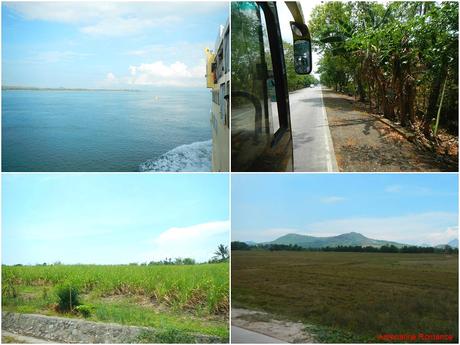
We arrived at the bustling port town of Estancia at 1PM. Ravenously hungry, we wolfed a heavy lunch that centered around large servings of delicious linat-ang baka (stewed beef mixed with vegetables). After a satisfying meal, we bought some last-minute supplies.
Estancia has one of the busiest fish markets we’ve ever been. We later learned that it is one of the most developed fish ports in northern Visayas. Fishermen as far as Daan Bantayan, Masbate, and Romblon come here to sell their catches.

After meeting Edcel, our Cebuano-speaking guide (much to our relief), we boarded our pumpboat that will take us to Islas de Gigantes. We had to be careful in boarding the boat because the steps are ultra slippery.

A few revs of the engine and we were on our way to exit the shallow bay. Everyone was definitely excited for this trip.

We saw a huge number of bamboo fish pens and fishing boats along the bay. The waters that surround Estancia are extremely rich fishing grounds. Because of the bountiful marine resources in the area, Estancia is considered to be one of the country’s hub for commercial fishing.
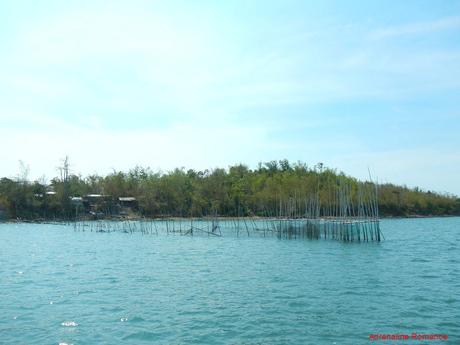
The bay is also a bustling naval highway for small to medium boats. During our trip, there seemed to be a non-stop stream of arriving and departing pumpboats.

Soon, we left Estancia’s sheltered inlet and sailed in deep water to Islas de Gigantes. From the bay’s exit, we could already see the archipelago’s biggest islands.
The hot afternoon weather was totally calm, and we sailed comfortably over smooth seas.

Check out this lone sandy island which juts right in the middle of the sea. According to Edcel, there was supposed to be a small coconut grove here. After the powerful Typhoon Haiyan (Yolanda) devastated the area, only a sole coconut tree survived!

As we neared Islas de Gigantes, we could clearly see the details of its biggest islands. The photo below shows Gigantes Norte, an island dotted with fishing communities populated by Cebuano-speaking fishermen.
Although Gigantes Norte is mainly rocky, the hill on the left side of the island is arable. In fact, as we neared the island, we saw the hill being plowed in preparation for planting crops.

Our destination, however, is in nearby Gigantes Sur, which is separated from Gigantes Norte with a narrow channel that is less than a kilometer wide. Low and lightly wooded hills, small grasslands, and rocky limestone cliffs make up Gigantes Sur.

Uhmm…did we say rocky limestone cliffs? Our hands itched as we fantasized it being a developed crag.

Our boat was supposed to dock at the resort that we booked, but it was diverted to the small town’s beach due to the receding tide. Thus, we had to ride habal-habals to reach Rosewood Place, a humble seaside resort.
Habal-habals, by the way, are the main modes of transportation around Gigantes Sur. The streets are so narrow that driving four-wheeled vehicles around the island is impractical.

The sweat, salt water, dust, and heat made us feel itchy and uncomfortable. It was time to wash off the gunk by dipping into the knee-deep water. Yes, you heard that right—knee-deep water due to the extremely low tide.
We did, however, felt refreshed as the warm seawater caressed our bodies. We also took photos of some interesting globular corals that we found under the water.

These are common stove-pipe sponges. Sponges such as these get their food by absorbing the surrounding water at the bottom. Special hair-like structures in their bodies filter out water-borne microorganisms that they consume for food. Then they eject that water at the top.
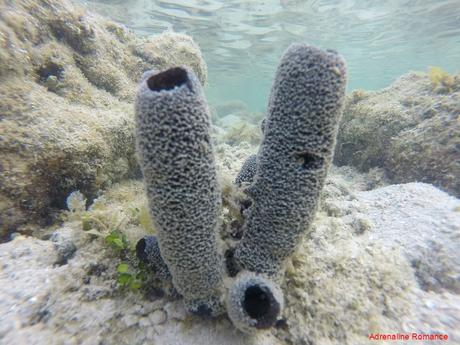
After having our fill of low-tide swimming, we washed up and ate a sumptuous seafood dinner of steamed crabs, squid stew, and scallops cooked adobo style. Yummy!

Check out our simple yet cozy family room! Cool sea air permeates through tiny holes in the weaved walls, making the room comfortably cool even without air conditioning.

Well, enough of our first day; we just want to set the mood for the rest of our tale. Here’s a sneak peak of our two-day adventure around Islas de Gigantes.
Our second day constitutes the main part of our adventure—visiting and exploring picturesque and white-sand islands that deserve their descriptions of being tropical paradises.
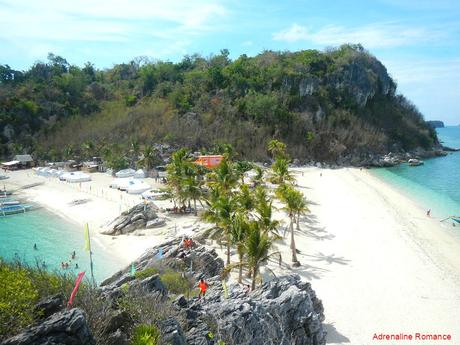
We started our third day with an early morning visit at an important historical and cultural remnant in this archipelago.

We capped off our Islas de Gigantes trip with an unexpected adventure in an underground cathedral that was hewed from pure limestone for thousands upon thousands of years.

Come with us as we take you to some of the most beautiful island paradises in Western Visayas.
Since this weekend trip covered several destinations and activities, we will write each activity in detail in separate posts. For your convenience, we will hyperlink our adventures from this page. Stay tuned!
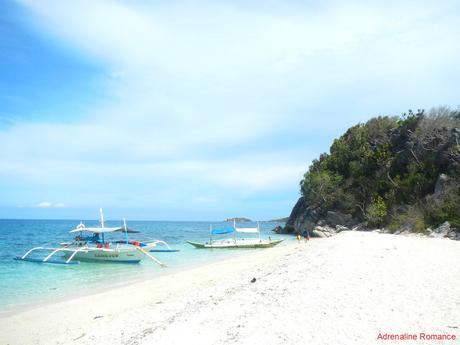
Day 1 – Going to Islas de Gigantes from Estancia (this post)
Day 2 – Island Hopping in Islas de Gigantes
Day 3 – Inland Tour and Caving at Bakwitan Cave
Itinerary for Iloilo to Estancia
Day 0
8:00 PM – leave Cebu port
Day 1
9:00 AM – dock at Iloilo port, breakfast
9:30 AM – ride jeep to Tagbak Bus Terminal
10:00 AM – depart Iloilo, travel to Estancia
1:00 PM – arrival at Estancia, lunch, meet guide
2:30 PM – boat ride to Gigantes Sur
4:00 PM – arrival at Gigantes Sur, habal-habal ride to Rosewood Place
4:15 PM – arrival at Rosewood Palace, swimming, sunset viewing, free time
6:00 PM – dinner
8:00 PM – freshen up, lights off, sleep
Estimated Budget for Iloilo to Estancia (and vice versa)*
- P 800 per person – boat fare (Cokaliong), Cebu to Iloilo
- P 25 per person – terminal fee
- P 7 per person – jeepney fare from port to Iloilo city center**
- P 7 per person – jeepney fare from Iloilo city center to Tagbak Bus Terminal**
- P 150 per person – bus fare from Iloilo to Estancia
- P 10 per person – tricycle fare from Estancia bus terminal to Estancia port
Sometimes, you may not be able to catch a bus that goes directly to Estancia from the Tagbak Bus Terminal due to an erratic or awkward schedule. In that case, ride a bus that goes to Balasan. Stop at the crossing then ride a tricycle to Estancia port.
- P 145 per person – bus fare from Iloilo to Balasan-Estancia crossing
- P 15 per person – tricycle fare from Balasan-Estancia crossing to Estancia port
* We did not include our expenses for meals, snacks, souvenirs, tips, and other fees in this rate sheet as you may have different needs, preferences, itineraries, and sharing scheme from us. Note that all figures are subject to change without prior notice. The rates for the activities and adventures in Islas de Gigantes will be published in the next blog post.
** We are not exactly sure which part of the city center we disembarked from the jeep. We just told the jeepney driver to drop us off where we can ride a jeep to Tagbak Bus terminal. We recommend you do the same. However, note that the fare is only 7 (or minimum jeepney fare in case the rate changes in the future); be wary of drivers who overcharge you.
Tips
1. For your Islas de Gigantes island hopping adventure and inland tour, get in touch with Mr. Edcel Arnado at 0930-2721063. He is accredited by the Iloilo Provincial Department, so you are assured of his reliability. He is also a staff of Rosewood Place Resort, so he can assist you in booking your accommodations.
2. Cokaliong Shipping Lines has ships that ply Cebu to Iloilo City (and vice versa) route. Check out their ferry schedule below.
Cebu to Iloilo
- Tuesday, Thursday, and Saturday – ETD Cebu 7 PM; ETA Iloilo 8 AM the next day
Iloilo to Cebu
- Wednesday, Friday, and Sunday – ETD Iloilo 7PM; ETA Cebu 8 AM the next day
3. It is best to visit Islas de Gigantes during the sunny, summer months of February to June when the seas are smooth and calm.
4. Take time to set your itinerary, schedules, and budget for a smoother, hassle-free trip.
5. Reserve your tours and accommodations with the providers at least two weeks to avoid headaches. Reconfirm your booking a day before and on your arrival.
6. If possible and if you have a means of communicating with travel service providers and local guides, negotiate and arrange a deal with them beforehand. During the negotiation and arrangement, ensure that you know what is included in the price that you are about to agree on. You wouldn’t want it if your guide suddenly asks extra money for gas or a meal, an expense that wasn’t part of your negotiation, right?
7. Pack light; it makes traveling faster, easier, and more efficient than ever. Do bring the following in your backpack.
- water (at least 1 liter)
- dry-fit, comfortable clothes for traveling
- bathing suit, rash guard, bikini, or trunks
- extra underwear
- sleepwear
- sweater
- shorts
- trekking shoes or sandals
- umbrella, hat, or scarf
- rain gear (in case of bad weather)
- medications (if any)
- toiletries
- face towel
- snacks
- goggles or snorkel equipment
- cell phone
- camera (waterproof or GoPro cameras are recommended)
- chargers
- extra money
8. Waterproof your stuff by wrapping them in dry sacks or plastic bags before putting them in your backpack.

